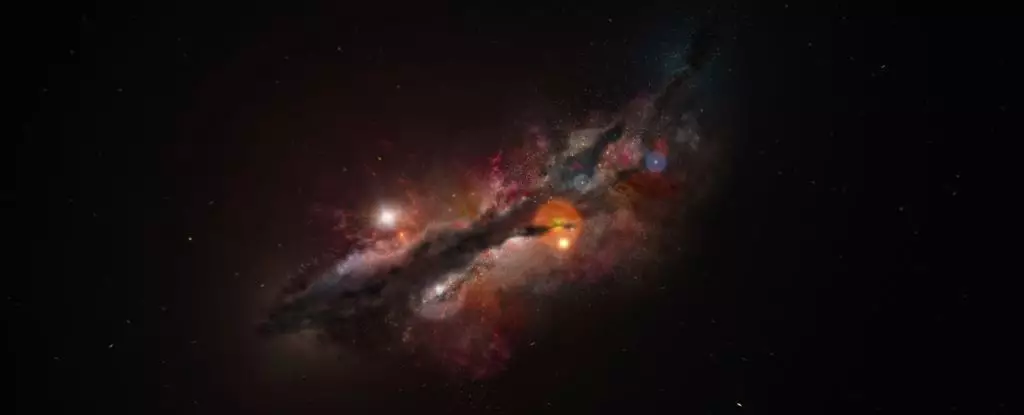In a groundbreaking breakthrough that tantalizes the very fabric of our understanding of cosmology, astronomers have observed a galaxy named JADES-GS-z14-0, dating back to just 300 million years after the Big Bang. This discovery is not merely another speck in the cosmic tapestry; it’s an emblem of how our perceptions of galaxy formation and the maturation of the universe may be fundamentally flawed. The significant presence of oxygen within JADES-GS-z14-0 raises poignant questions, demanding scientists to reevaluate timelines concerning elemental formation and galaxy growth in the infancy of the cosmos.
JADES-GS-z14-0 is unexpectedly rich in oxygen, an element thought to be sparse during such an early phase of the universe’s development. The existence of this galaxy presents a temporal conundrum: how could a galaxy of this magnitude form and evolve so early in cosmic history? According to cosmologist Sander Schouws, the discovery is akin to finding an adolescent where only newborns should exist, suggesting that the universe’s developmental timeline is indeed much more compressed than previously theorized.
Rethinking Cosmic Models
To grasp the enormity of this revelation, we must dive deeper into the essential framework surrounding cosmic evolution. Our model of the universe posits that galaxies require substantial spans of time to coalesce from primordial gases. Early on, during the Big Bang, the universe birthed primarily hydrogen and helium atoms. These gases coalesced under the force of gravity, leading to the formation of the first stars, which sparked the fusion process that would eventually produce heavier elements like oxygen.
However, the Irony is striking: for oxygen and similar elements to be expelled into space, ancient stars must have completed their life cycles by dying in supernova explosions. This process generally demands millions of years. Yet the measurements obtained from JADES-GS-z14-0 indicate that oxygen levels are starkly higher—approximately ten times what was anticipated—since these primordial galaxies should not have had enough time to produce such quantities.
Astrophysicist Stefano Carniani expressed astonishment at these results, emphasizing how they could reshape our comprehension of the early cosmic evolution stages. To suggest that this galaxy was already quite ‘mature’ during the early universe compels astronomers to reconsider fundamental assumptions about when and how galaxies came to be.
The Role of Advanced Technology
The observations of JADES-GS-z14-0 were made possible through the advanced capabilities of the James Webb Space Telescope (JWST), a monumental leap in astronomical technology. The JWST is specifically engineered to capture infrared light from distant galaxies, revealing the properties of objects that are redshifted due to the universe’s expansion. As light journeys across billions of light-years, it stretches, providing astronomers with insights into the composition and behavior of ancient celestial bodies.
The advent of such powerful imaging has enabled astronomers to repeatedly discover massive galaxies in epochs previously deemed unexpected. The continuous proliferation of these observational data is challenging our understanding of early universe cosmology and heightening our intrigue about the processes governing galaxy formation. The presence of oxygen and other heavier elements in these galaxies suggests a universe that not only aged faster but also matured more sophisticatedly than we initially believed.
Implications for Cosmology
Each revelation surrounding the composition of early galaxies, particularly oxygen-rich entities like JADES-GS-z14-0, adds layers to the intricate puzzle of cosmic history. This urgency to reconcile new findings with existing models sparks vital discussions within the scientific community. Are we undervaluing the speed at which galaxy formation occurred? Do we need to reassess our timelines and theoretical frameworks about how elements evolve in the early universe?
As we process this information, it would be naive to think that our understanding of cosmic history is merely undergoing refinement; rather, it may be undergoing a radical transformation. Every unexpected discovery not only refines our knowledge but also serves as a catalyst, urging further investigation into the conditions and processes that contributed to the rapid progression of early galaxies.
Thus, as we continue to glean insights from the depths of space, we journey beyond mere observations; we pave a road layered with questions and potential answers, inviting scientists and cosmologists alike to expand their horizons and challenge that which was once considered unalterable. The breathtaking discovery of JADES-GS-z14-0 is not merely a triumph of observational astronomy—it’s a call to reimagine the cosmic narrative.

